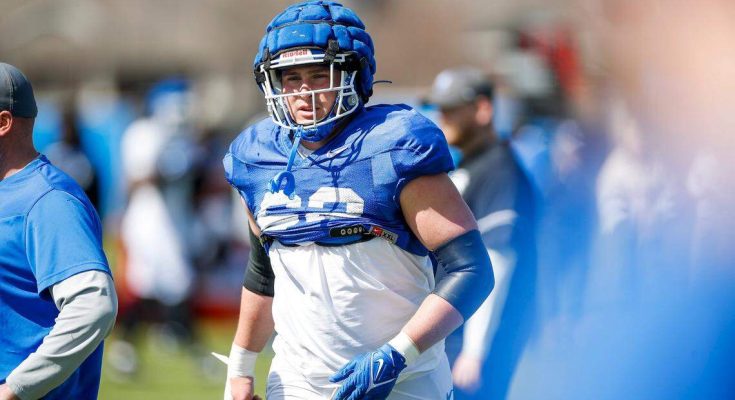From Guard to the Anchor: Jager Burton’s Second Shot at Center for Kentucky Football
The relentless pressure to perform, to adapt, and to ultimately succeed is a defining characteristic of a high-level athlete. For Jager Burton, a promising offensive lineman for the Kentucky Wildcats, this pressure took on a new dimension during the 2023 season. After a successful collegiate career at guard, Burton was thrust into a new role at the heart of the offensive line—center.1 It was a move born of necessity and high expectations, a strategic adjustment aimed at fortifying the Wildcats’ front five. However, the switch was short-lived, lasting only three games before Burton was moved back to his more familiar position.2 The experience was a difficult one, a public trial that left questions about his ability to handle the intricacies of the center position. Now, with a new season on the horizon, Burton is getting a second chance to prove himself. He is not just returning to the center position; he is returning with a renewed focus, a refined skill set, and a determination to show that his first attempt was not a failure, but a crucial learning experience that has prepared him for success.3
The transition from guard to center is far more complex than a simple change of position. While both roles are on the interior of the offensive line, the center is the undisputed leader and most cerebral player of the unit.4 The center is responsible for making pre-snap calls, identifying defensive alignments, and communicating blocking schemes to the other linemen.5 They are the “quarterback of the offensive line,” a role that requires not only physical strength but also a deep understanding of the playbook and an ability to make split-second decisions under immense pressure. The physical demands also differ. Guards operate in a more confined space, often pulling and trapping, while centers are primarily focused on snapping the ball and then immediately engaging a defender, a task that requires a different kind of footwork and leverage. For Burton, a player who had established himself as an elite guard, this transition required a complete overhaul of his instincts and muscle memory. The snap itself is a significant hurdle; a flawless snap is a prerequisite for every play, and any miscue can derail the entire offensive series.6 In his brief stint at center, Burton faced these challenges head-on. There were moments of brilliance, flashes of the power and athleticism that made him a standout recruit, but there were also struggles with the nuances of the position.7 The team’s performance, particularly in those first three games, reflected some of these growing pains. The decision to move him back to guard was a pragmatic one, a move to stabilize the offensive line and put Burton back in a position where he could immediately contribute at a high level.
The experience of being moved back to guard could have been a demoralizing one. It could have been seen as a vote of no confidence, a clear indication that he was not cut out for the center position. But for Burton, it appears to have been the opposite. It was a catalyst for growth, a powerful motivator to refine his craft and address the areas where he fell short. Over the offseason, Burton has been a man on a mission. He has dedicated himself to mastering the intricacies of the center position.8 This has meant countless hours of film study, meticulously analyzing every snap, every blocking assignment, and every defensive front. He has worked tirelessly with the coaching staff, particularly with the offensive line coach, to hone his technique. This includes everything from his snapping motion to his footwork and his ability to quickly diagnose a defense. The physical transformation is also evident; Burton has used the time to get stronger and more agile, ensuring he has the explosive power needed to anchor the line against some of the SEC’s most formidable defensive tackles.9 The mental side of the game has been just as important. Burton has embraced the leadership role, taking command in practice, and working to build a seamless rapport with his fellow linemen.10 He is no longer just a talented guard; he is a player who understands the full scope of what it means to be the center of an SEC offensive line. This renewed commitment has not gone unnoticed by his teammates and coaches, who have spoken about his maturity and dedication.11
Burton’s second shot at center is a key storyline for the Wildcats heading into the upcoming season. The success of the offensive line, and by extension the entire offense, hinges on his ability to anchor the front five. A successful transition would not only solidify the offensive line but also unlock the full potential of the team’s running and passing games. With a talented quarterback and a dynamic group of skill players, the Wildcats have the pieces in place to have an explosive offense. But it all starts up front, with the center making the calls and setting the tone.12 If Burton can successfully make the transition, it will be a testament to his resilience and work ethic. It will also be a major win for the coaching staff, validating their belief that he has the talent and the intelligence to excel at the position. The story of Jager Burton is more than just a position switch; it is a narrative about overcoming adversity, embracing a challenge, and striving for excellence. It is a story that will be watched closely by fans and analysts alike, as Burton steps back onto the field, ready to prove that he is not only capable of playing center, but that he can be the dominant, reliable anchor that the Kentucky Wildcats need to compete at the highest level of college football.13



